TFS Corporation (Quintis) Case Study: Governance, Fraud & Analysis
VerifiedAdded on 2023/06/09
|12
|2476
|282
Report
AI Summary
This report analyzes the downfall of TFS Corporation Ltd, focusing on failures in corporate governance and allegations of fraud, including the role of Blackrock in its demise. It examines weaknesses in the company's corporate governance policies, unrealistic financial forecasts, and criticisms from the Glaucus report. Additionally, the report evaluates Harvey Norman's remuneration strategies for executives and non-executive directors, highlighting the components of their compensation packages and alignment with company goals. The document is available on Desklib, a platform offering study tools and solved assignments for students.
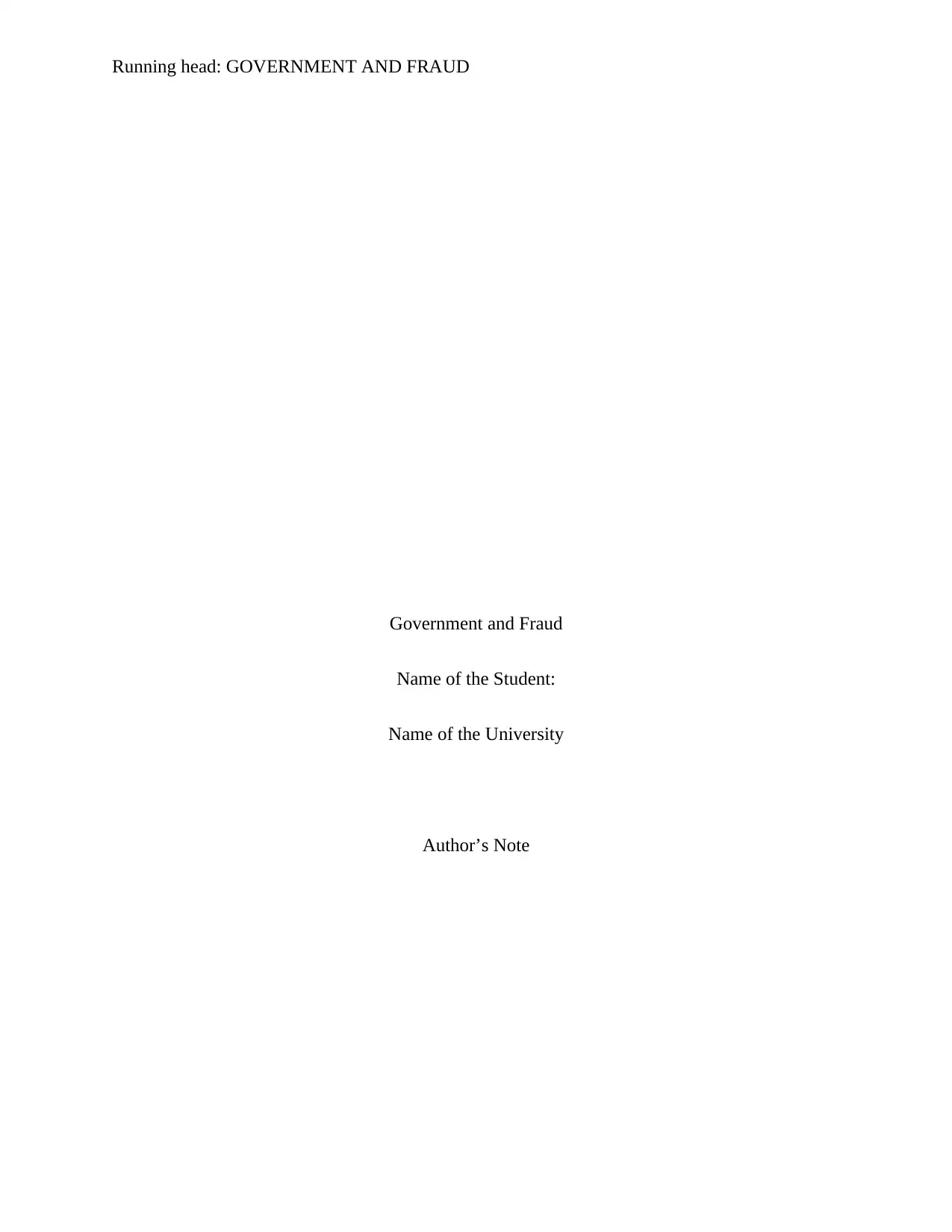
Running head: GOVERNMENT AND FRAUD
Government and Fraud
Name of the Student:
Name of the University
Author’s Note
Government and Fraud
Name of the Student:
Name of the University
Author’s Note
Paraphrase This Document
Need a fresh take? Get an instant paraphrase of this document with our AI Paraphraser
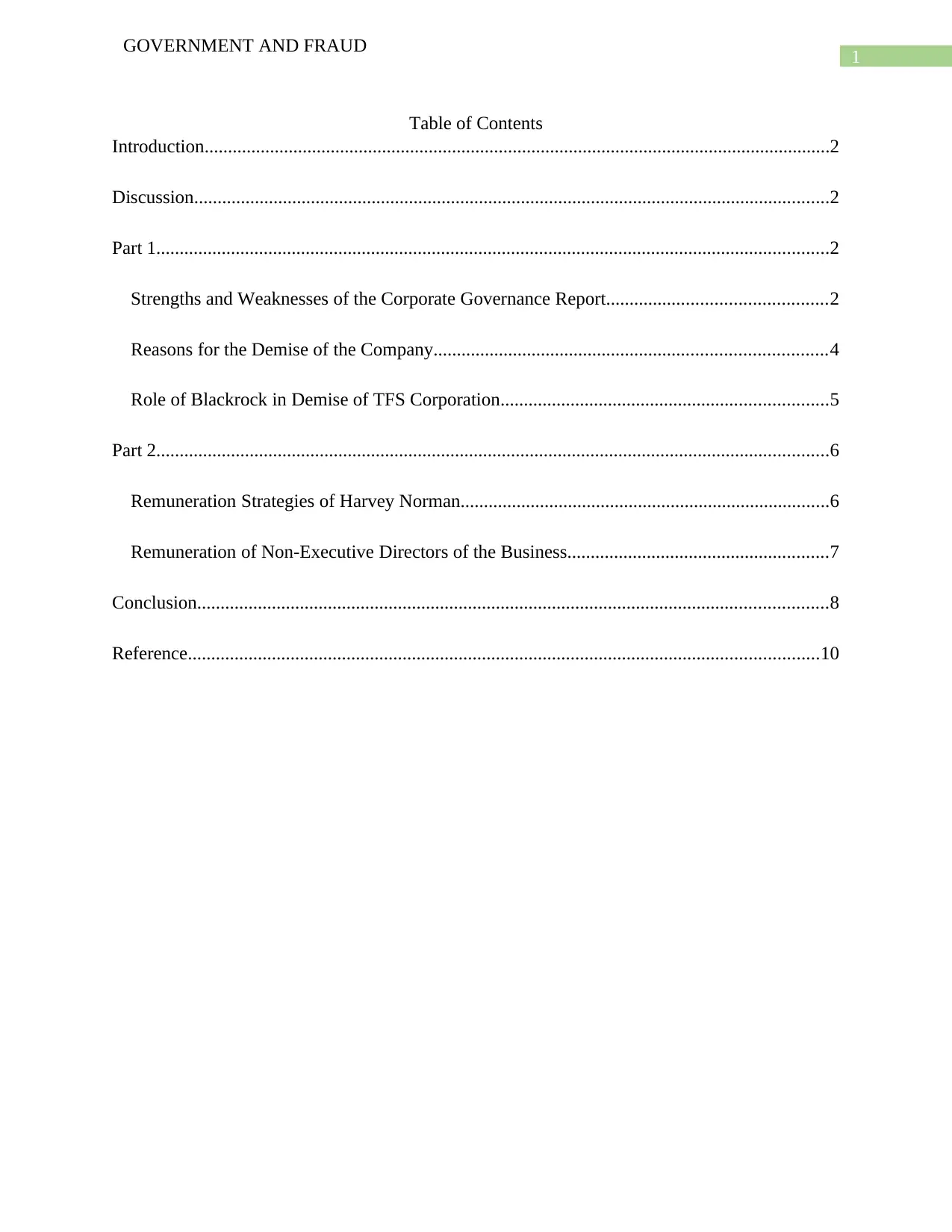
1
GOVERNMENT AND FRAUD
Table of Contents
Introduction......................................................................................................................................2
Discussion........................................................................................................................................2
Part 1................................................................................................................................................2
Strengths and Weaknesses of the Corporate Governance Report...............................................2
Reasons for the Demise of the Company....................................................................................4
Role of Blackrock in Demise of TFS Corporation......................................................................5
Part 2................................................................................................................................................6
Remuneration Strategies of Harvey Norman...............................................................................6
Remuneration of Non-Executive Directors of the Business........................................................7
Conclusion.......................................................................................................................................8
Reference.......................................................................................................................................10
GOVERNMENT AND FRAUD
Table of Contents
Introduction......................................................................................................................................2
Discussion........................................................................................................................................2
Part 1................................................................................................................................................2
Strengths and Weaknesses of the Corporate Governance Report...............................................2
Reasons for the Demise of the Company....................................................................................4
Role of Blackrock in Demise of TFS Corporation......................................................................5
Part 2................................................................................................................................................6
Remuneration Strategies of Harvey Norman...............................................................................6
Remuneration of Non-Executive Directors of the Business........................................................7
Conclusion.......................................................................................................................................8
Reference.......................................................................................................................................10
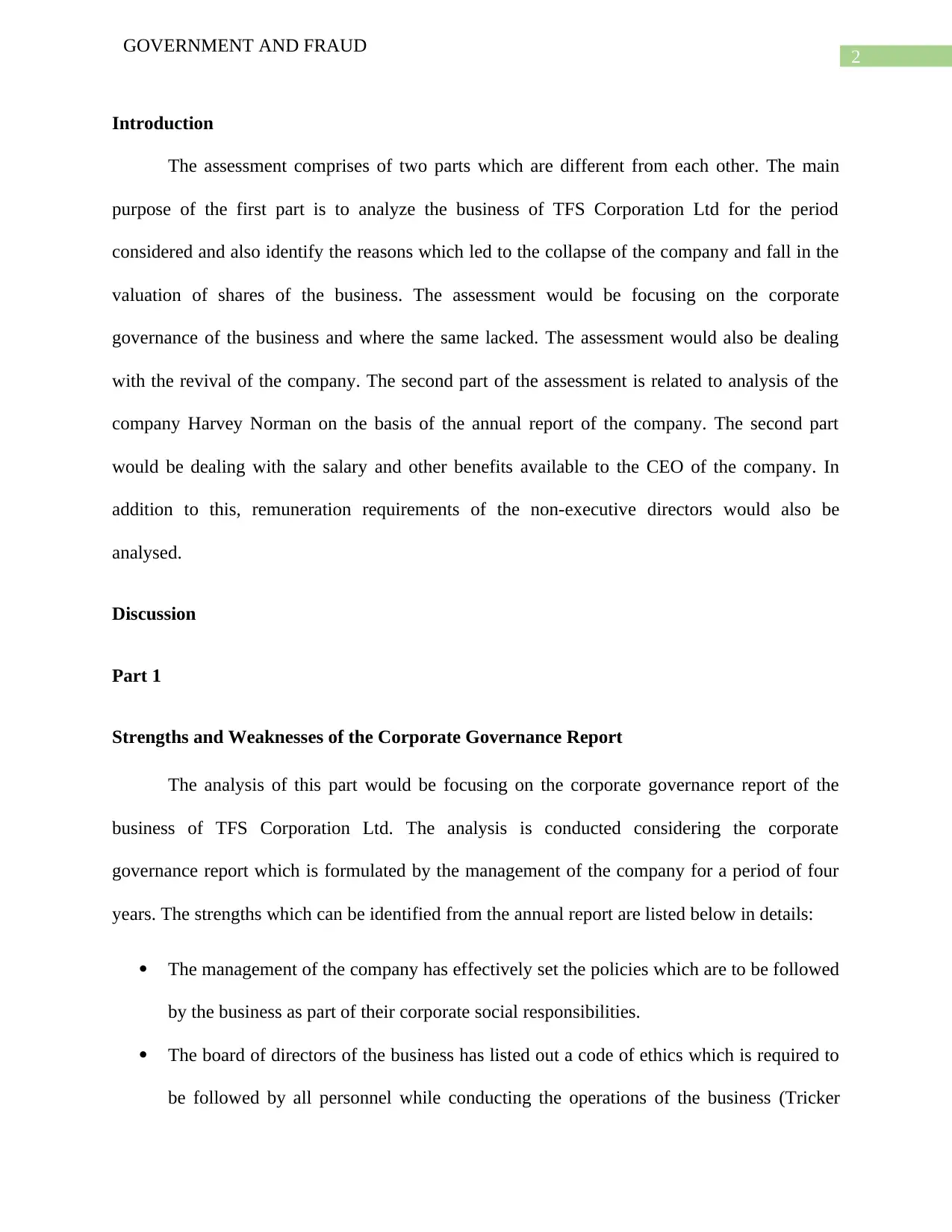
2
GOVERNMENT AND FRAUD
Introduction
The assessment comprises of two parts which are different from each other. The main
purpose of the first part is to analyze the business of TFS Corporation Ltd for the period
considered and also identify the reasons which led to the collapse of the company and fall in the
valuation of shares of the business. The assessment would be focusing on the corporate
governance of the business and where the same lacked. The assessment would also be dealing
with the revival of the company. The second part of the assessment is related to analysis of the
company Harvey Norman on the basis of the annual report of the company. The second part
would be dealing with the salary and other benefits available to the CEO of the company. In
addition to this, remuneration requirements of the non-executive directors would also be
analysed.
Discussion
Part 1
Strengths and Weaknesses of the Corporate Governance Report
The analysis of this part would be focusing on the corporate governance report of the
business of TFS Corporation Ltd. The analysis is conducted considering the corporate
governance report which is formulated by the management of the company for a period of four
years. The strengths which can be identified from the annual report are listed below in details:
The management of the company has effectively set the policies which are to be followed
by the business as part of their corporate social responsibilities.
The board of directors of the business has listed out a code of ethics which is required to
be followed by all personnel while conducting the operations of the business (Tricker
GOVERNMENT AND FRAUD
Introduction
The assessment comprises of two parts which are different from each other. The main
purpose of the first part is to analyze the business of TFS Corporation Ltd for the period
considered and also identify the reasons which led to the collapse of the company and fall in the
valuation of shares of the business. The assessment would be focusing on the corporate
governance of the business and where the same lacked. The assessment would also be dealing
with the revival of the company. The second part of the assessment is related to analysis of the
company Harvey Norman on the basis of the annual report of the company. The second part
would be dealing with the salary and other benefits available to the CEO of the company. In
addition to this, remuneration requirements of the non-executive directors would also be
analysed.
Discussion
Part 1
Strengths and Weaknesses of the Corporate Governance Report
The analysis of this part would be focusing on the corporate governance report of the
business of TFS Corporation Ltd. The analysis is conducted considering the corporate
governance report which is formulated by the management of the company for a period of four
years. The strengths which can be identified from the annual report are listed below in details:
The management of the company has effectively set the policies which are to be followed
by the business as part of their corporate social responsibilities.
The board of directors of the business has listed out a code of ethics which is required to
be followed by all personnel while conducting the operations of the business (Tricker
⊘ This is a preview!⊘
Do you want full access?
Subscribe today to unlock all pages.

Trusted by 1+ million students worldwide
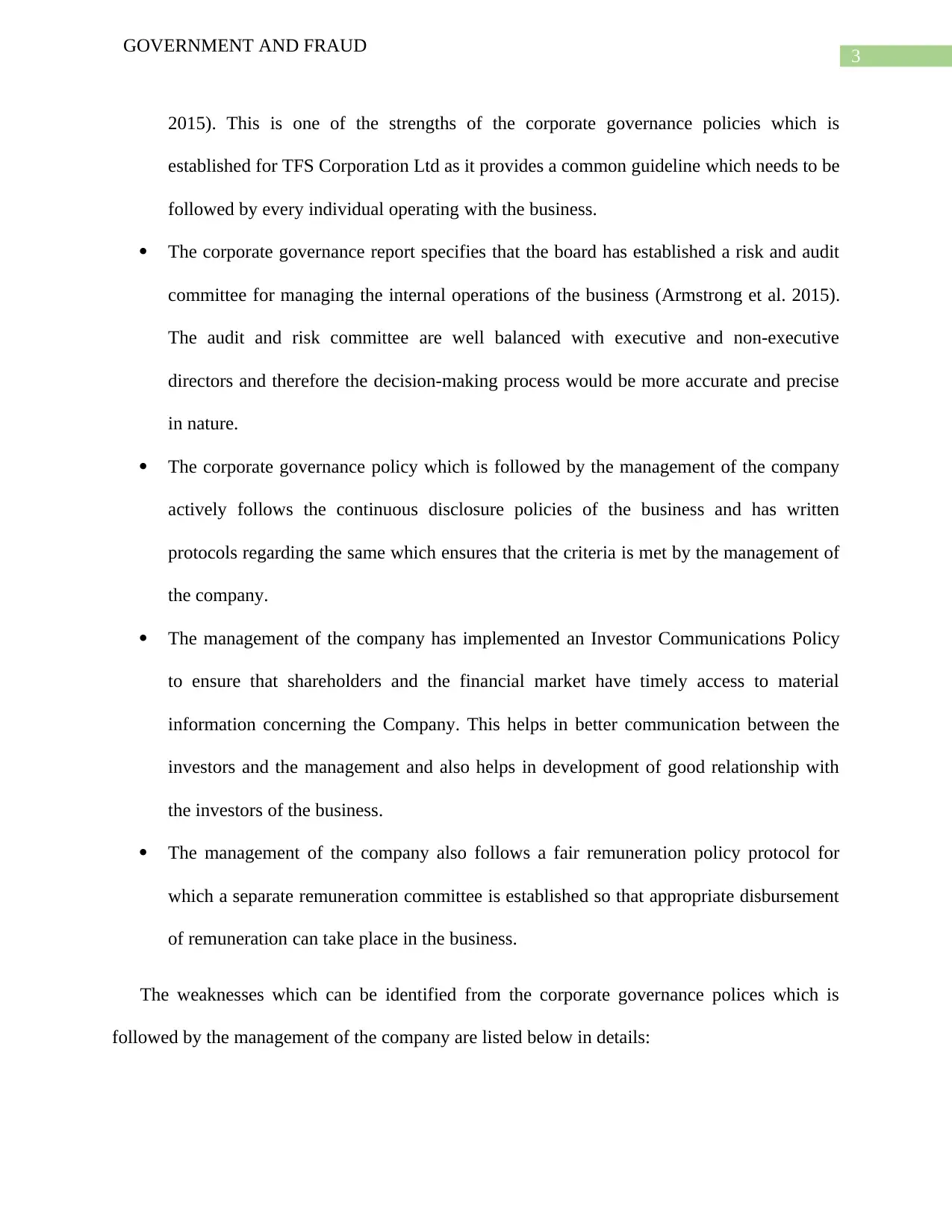
3
GOVERNMENT AND FRAUD
2015). This is one of the strengths of the corporate governance policies which is
established for TFS Corporation Ltd as it provides a common guideline which needs to be
followed by every individual operating with the business.
The corporate governance report specifies that the board has established a risk and audit
committee for managing the internal operations of the business (Armstrong et al. 2015).
The audit and risk committee are well balanced with executive and non-executive
directors and therefore the decision-making process would be more accurate and precise
in nature.
The corporate governance policy which is followed by the management of the company
actively follows the continuous disclosure policies of the business and has written
protocols regarding the same which ensures that the criteria is met by the management of
the company.
The management of the company has implemented an Investor Communications Policy
to ensure that shareholders and the financial market have timely access to material
information concerning the Company. This helps in better communication between the
investors and the management and also helps in development of good relationship with
the investors of the business.
The management of the company also follows a fair remuneration policy protocol for
which a separate remuneration committee is established so that appropriate disbursement
of remuneration can take place in the business.
The weaknesses which can be identified from the corporate governance polices which is
followed by the management of the company are listed below in details:
GOVERNMENT AND FRAUD
2015). This is one of the strengths of the corporate governance policies which is
established for TFS Corporation Ltd as it provides a common guideline which needs to be
followed by every individual operating with the business.
The corporate governance report specifies that the board has established a risk and audit
committee for managing the internal operations of the business (Armstrong et al. 2015).
The audit and risk committee are well balanced with executive and non-executive
directors and therefore the decision-making process would be more accurate and precise
in nature.
The corporate governance policy which is followed by the management of the company
actively follows the continuous disclosure policies of the business and has written
protocols regarding the same which ensures that the criteria is met by the management of
the company.
The management of the company has implemented an Investor Communications Policy
to ensure that shareholders and the financial market have timely access to material
information concerning the Company. This helps in better communication between the
investors and the management and also helps in development of good relationship with
the investors of the business.
The management of the company also follows a fair remuneration policy protocol for
which a separate remuneration committee is established so that appropriate disbursement
of remuneration can take place in the business.
The weaknesses which can be identified from the corporate governance polices which is
followed by the management of the company are listed below in details:
Paraphrase This Document
Need a fresh take? Get an instant paraphrase of this document with our AI Paraphraser

4
GOVERNMENT AND FRAUD
The management of the company does not properly supervise the policies which are
already established and therefore it is uncertain whether the policies which are
established are actually being followed or not.
The management of the company does not have a separate nomination committee and
therefore the appointments which is required to be made to senior positions may not be
done in a just manner. In addition to this, the board of directors of the business is required
to execute this role and therefore this puts addition burden to their responsibilities which
can lead to inefficiency.
The company policies have been criticized by the Glaucus report that the company is in
the habit of acquiring long term loans on the promise of future profits which is not likely
the case and therefore the company’s proposals are dubious in nature (Bell, Filatotchev
and Aguilera 2014).
In addition to this, there have been several instances of mismanagement in the business as
the business is often referred to follow a Ponzi scheme in its dealings. In addition to this,
the business has made unrealistic sales forecast with the intention of accumulating
required amount of capitals for a project.
The audit and risk committee which is established by the business might not be following
proper internal control checks for the business and therefore this can be regarded as one
of the major weaknesses for the business.
Reasons for the Demise of the Company
The main reason which can be identified for the fall of the company is the improper
corporate governance policies and their implementation in the business (Larcker and Tayan
2015). The board of directors have formulated appropriate plans for the business but the same
GOVERNMENT AND FRAUD
The management of the company does not properly supervise the policies which are
already established and therefore it is uncertain whether the policies which are
established are actually being followed or not.
The management of the company does not have a separate nomination committee and
therefore the appointments which is required to be made to senior positions may not be
done in a just manner. In addition to this, the board of directors of the business is required
to execute this role and therefore this puts addition burden to their responsibilities which
can lead to inefficiency.
The company policies have been criticized by the Glaucus report that the company is in
the habit of acquiring long term loans on the promise of future profits which is not likely
the case and therefore the company’s proposals are dubious in nature (Bell, Filatotchev
and Aguilera 2014).
In addition to this, there have been several instances of mismanagement in the business as
the business is often referred to follow a Ponzi scheme in its dealings. In addition to this,
the business has made unrealistic sales forecast with the intention of accumulating
required amount of capitals for a project.
The audit and risk committee which is established by the business might not be following
proper internal control checks for the business and therefore this can be regarded as one
of the major weaknesses for the business.
Reasons for the Demise of the Company
The main reason which can be identified for the fall of the company is the improper
corporate governance policies and their implementation in the business (Larcker and Tayan
2015). The board of directors have formulated appropriate plans for the business but the same

5
GOVERNMENT AND FRAUD
have not properly followed by the business. The business has also faced criticism regarding the
business offering false promises for the purpose of acquiring finances from capital market. In
combination to this, there is also the relation of the business to Ponzi scheme for successfully
running the operations of the business.
The company has been questioned in Glaucus report regarding the Chinese buyer whom
the company claims to have entered into a huge contract with. The management of the company
has shown strong sales forecast and a strong cash flow which is mainly based on future market
price, yield and survivability and the sane cannot be considered to be important factors for the
business and therefore unrealistic (Jizi et al. 2014). The management of the company also values
its shares on the basis of these forecasts which is therefore unrealistic for the investors. These
factors have significantly affected the viability of the business and lead to the demise of the
business. The factors have contributed to the fall in the share value of the business and therefore
also affected the reputation of the business.
Role of Blackrock in Demise of TFS Corporation
The valuation reports of business reflected that the shares of the business were over
valued in order to attract more investors for making investments in the business. This lead to a
fall in the share price valuation of the business which significantly fell in comparison to half year
results. The company did not have appropriate amount of capital for financing the operations of
the business. In addition to this, due to the mismanagement of the business, ASX suspended the
business from the listing and this led to further fall in the share price of the business (Chan,
Watson and Woodliff 2014). The business was then acquired by Blackrock as majority of the
shares of the company had been taken over by Blackrock and this made the business a private
company. In such a process, the remaining shareholders of the company lost 100% of their
GOVERNMENT AND FRAUD
have not properly followed by the business. The business has also faced criticism regarding the
business offering false promises for the purpose of acquiring finances from capital market. In
combination to this, there is also the relation of the business to Ponzi scheme for successfully
running the operations of the business.
The company has been questioned in Glaucus report regarding the Chinese buyer whom
the company claims to have entered into a huge contract with. The management of the company
has shown strong sales forecast and a strong cash flow which is mainly based on future market
price, yield and survivability and the sane cannot be considered to be important factors for the
business and therefore unrealistic (Jizi et al. 2014). The management of the company also values
its shares on the basis of these forecasts which is therefore unrealistic for the investors. These
factors have significantly affected the viability of the business and lead to the demise of the
business. The factors have contributed to the fall in the share value of the business and therefore
also affected the reputation of the business.
Role of Blackrock in Demise of TFS Corporation
The valuation reports of business reflected that the shares of the business were over
valued in order to attract more investors for making investments in the business. This lead to a
fall in the share price valuation of the business which significantly fell in comparison to half year
results. The company did not have appropriate amount of capital for financing the operations of
the business. In addition to this, due to the mismanagement of the business, ASX suspended the
business from the listing and this led to further fall in the share price of the business (Chan,
Watson and Woodliff 2014). The business was then acquired by Blackrock as majority of the
shares of the company had been taken over by Blackrock and this made the business a private
company. In such a process, the remaining shareholders of the company lost 100% of their
⊘ This is a preview!⊘
Do you want full access?
Subscribe today to unlock all pages.

Trusted by 1+ million students worldwide
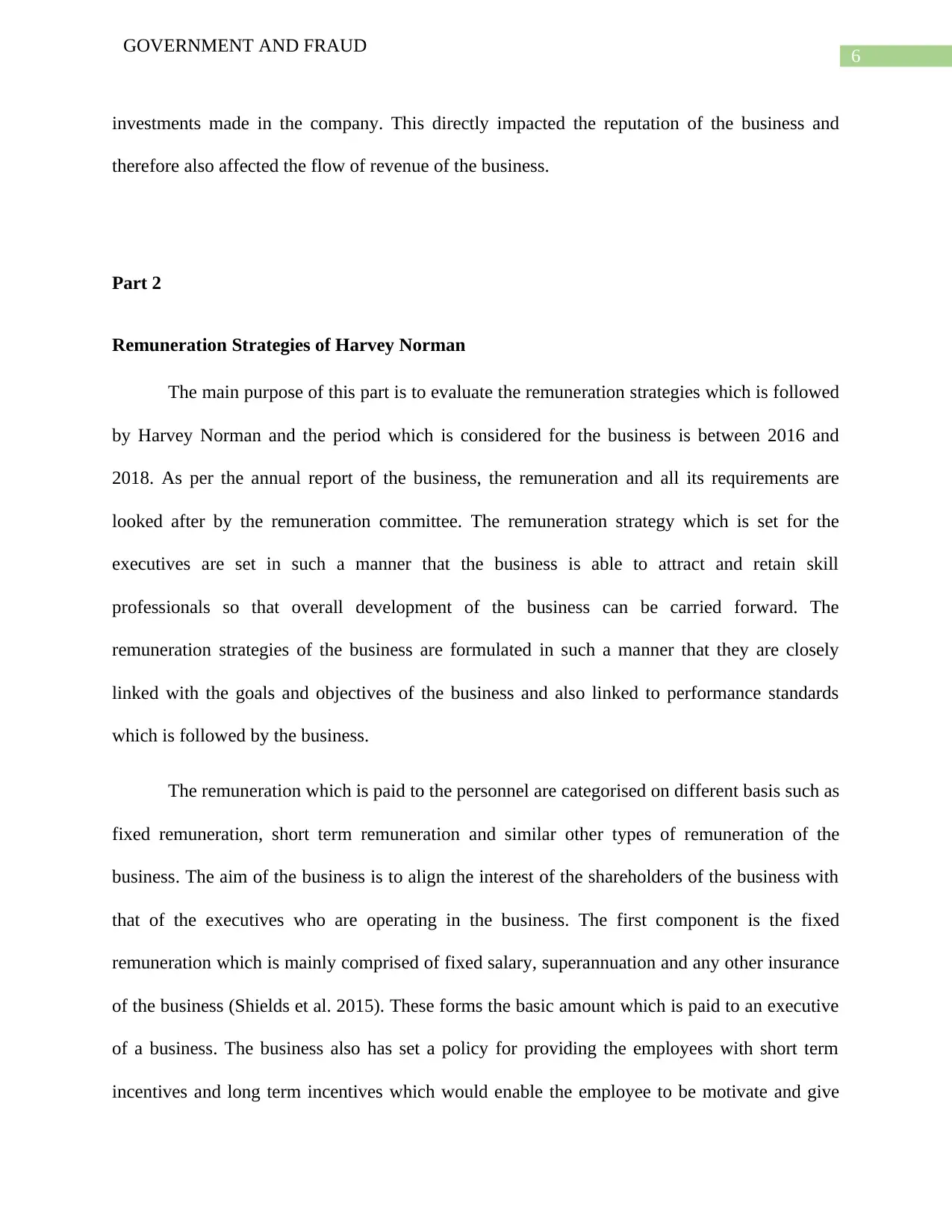
6
GOVERNMENT AND FRAUD
investments made in the company. This directly impacted the reputation of the business and
therefore also affected the flow of revenue of the business.
Part 2
Remuneration Strategies of Harvey Norman
The main purpose of this part is to evaluate the remuneration strategies which is followed
by Harvey Norman and the period which is considered for the business is between 2016 and
2018. As per the annual report of the business, the remuneration and all its requirements are
looked after by the remuneration committee. The remuneration strategy which is set for the
executives are set in such a manner that the business is able to attract and retain skill
professionals so that overall development of the business can be carried forward. The
remuneration strategies of the business are formulated in such a manner that they are closely
linked with the goals and objectives of the business and also linked to performance standards
which is followed by the business.
The remuneration which is paid to the personnel are categorised on different basis such as
fixed remuneration, short term remuneration and similar other types of remuneration of the
business. The aim of the business is to align the interest of the shareholders of the business with
that of the executives who are operating in the business. The first component is the fixed
remuneration which is mainly comprised of fixed salary, superannuation and any other insurance
of the business (Shields et al. 2015). These forms the basic amount which is paid to an executive
of a business. The business also has set a policy for providing the employees with short term
incentives and long term incentives which would enable the employee to be motivate and give
GOVERNMENT AND FRAUD
investments made in the company. This directly impacted the reputation of the business and
therefore also affected the flow of revenue of the business.
Part 2
Remuneration Strategies of Harvey Norman
The main purpose of this part is to evaluate the remuneration strategies which is followed
by Harvey Norman and the period which is considered for the business is between 2016 and
2018. As per the annual report of the business, the remuneration and all its requirements are
looked after by the remuneration committee. The remuneration strategy which is set for the
executives are set in such a manner that the business is able to attract and retain skill
professionals so that overall development of the business can be carried forward. The
remuneration strategies of the business are formulated in such a manner that they are closely
linked with the goals and objectives of the business and also linked to performance standards
which is followed by the business.
The remuneration which is paid to the personnel are categorised on different basis such as
fixed remuneration, short term remuneration and similar other types of remuneration of the
business. The aim of the business is to align the interest of the shareholders of the business with
that of the executives who are operating in the business. The first component is the fixed
remuneration which is mainly comprised of fixed salary, superannuation and any other insurance
of the business (Shields et al. 2015). These forms the basic amount which is paid to an executive
of a business. The business also has set a policy for providing the employees with short term
incentives and long term incentives which would enable the employee to be motivate and give
Paraphrase This Document
Need a fresh take? Get an instant paraphrase of this document with our AI Paraphraser
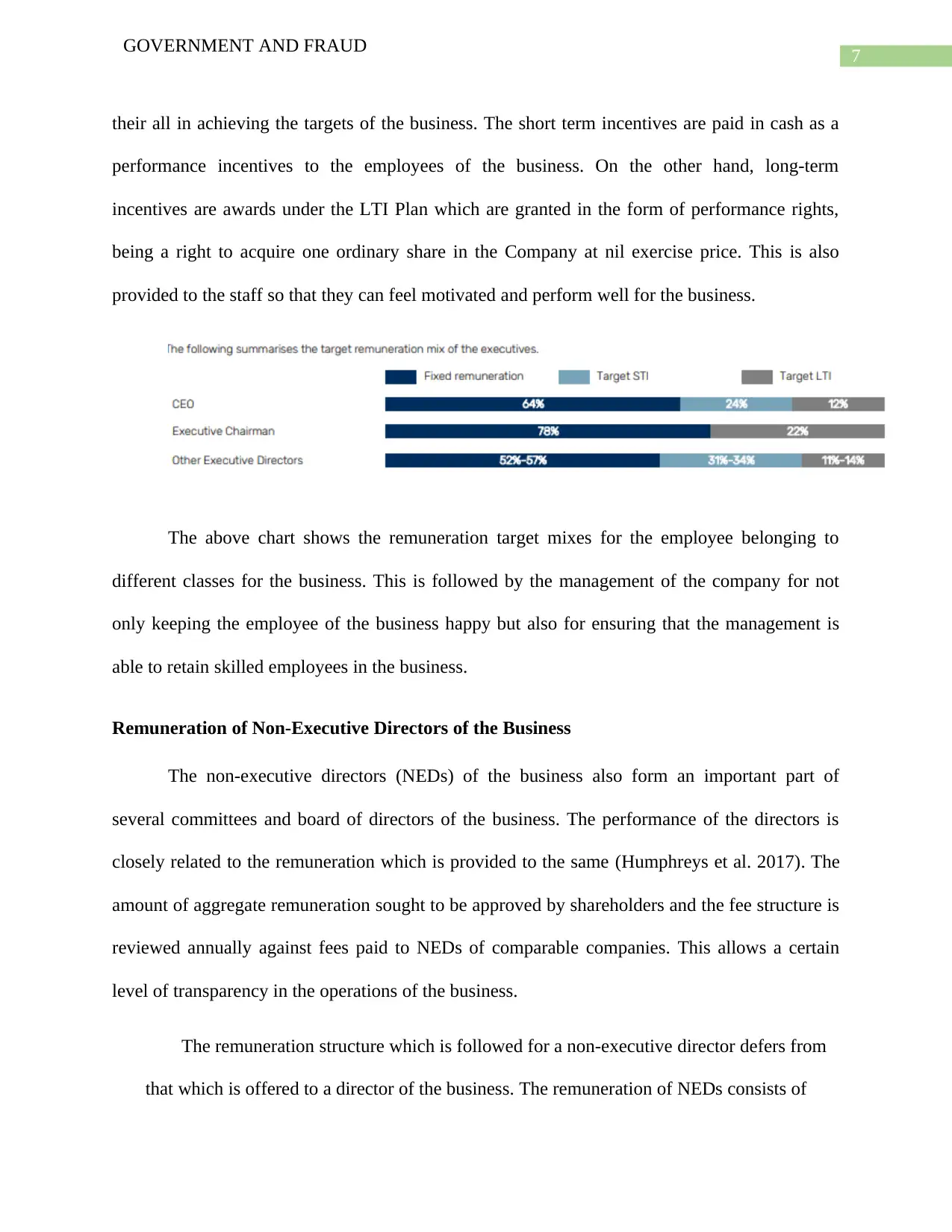
7
GOVERNMENT AND FRAUD
their all in achieving the targets of the business. The short term incentives are paid in cash as a
performance incentives to the employees of the business. On the other hand, long-term
incentives are awards under the LTI Plan which are granted in the form of performance rights,
being a right to acquire one ordinary share in the Company at nil exercise price. This is also
provided to the staff so that they can feel motivated and perform well for the business.
The above chart shows the remuneration target mixes for the employee belonging to
different classes for the business. This is followed by the management of the company for not
only keeping the employee of the business happy but also for ensuring that the management is
able to retain skilled employees in the business.
Remuneration of Non-Executive Directors of the Business
The non-executive directors (NEDs) of the business also form an important part of
several committees and board of directors of the business. The performance of the directors is
closely related to the remuneration which is provided to the same (Humphreys et al. 2017). The
amount of aggregate remuneration sought to be approved by shareholders and the fee structure is
reviewed annually against fees paid to NEDs of comparable companies. This allows a certain
level of transparency in the operations of the business.
The remuneration structure which is followed for a non-executive director defers from
that which is offered to a director of the business. The remuneration of NEDs consists of
GOVERNMENT AND FRAUD
their all in achieving the targets of the business. The short term incentives are paid in cash as a
performance incentives to the employees of the business. On the other hand, long-term
incentives are awards under the LTI Plan which are granted in the form of performance rights,
being a right to acquire one ordinary share in the Company at nil exercise price. This is also
provided to the staff so that they can feel motivated and perform well for the business.
The above chart shows the remuneration target mixes for the employee belonging to
different classes for the business. This is followed by the management of the company for not
only keeping the employee of the business happy but also for ensuring that the management is
able to retain skilled employees in the business.
Remuneration of Non-Executive Directors of the Business
The non-executive directors (NEDs) of the business also form an important part of
several committees and board of directors of the business. The performance of the directors is
closely related to the remuneration which is provided to the same (Humphreys et al. 2017). The
amount of aggregate remuneration sought to be approved by shareholders and the fee structure is
reviewed annually against fees paid to NEDs of comparable companies. This allows a certain
level of transparency in the operations of the business.
The remuneration structure which is followed for a non-executive director defers from
that which is offered to a director of the business. The remuneration of NEDs consists of
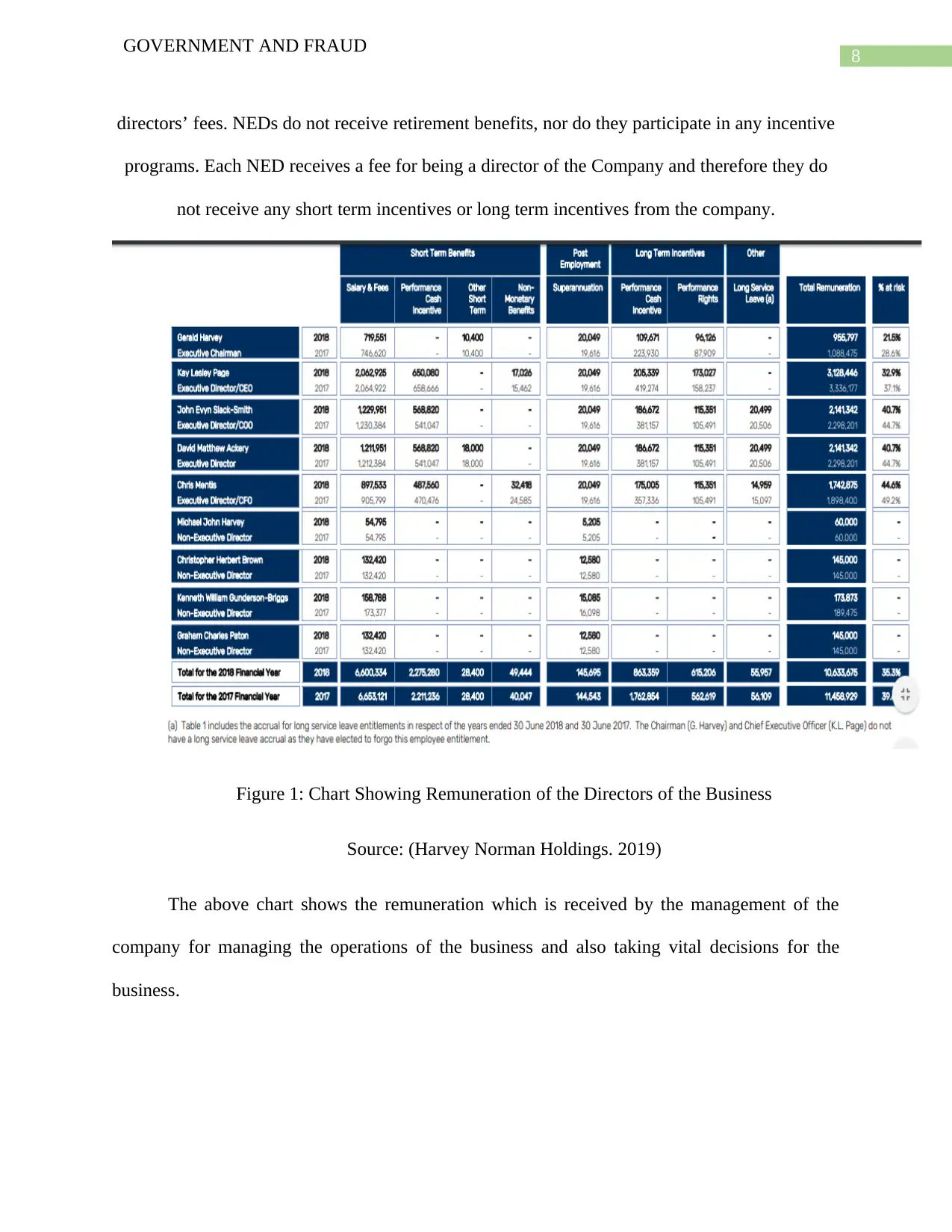
8
GOVERNMENT AND FRAUD
directors’ fees. NEDs do not receive retirement benefits, nor do they participate in any incentive
programs. Each NED receives a fee for being a director of the Company and therefore they do
not receive any short term incentives or long term incentives from the company.
Figure 1: Chart Showing Remuneration of the Directors of the Business
Source: (Harvey Norman Holdings. 2019)
The above chart shows the remuneration which is received by the management of the
company for managing the operations of the business and also taking vital decisions for the
business.
GOVERNMENT AND FRAUD
directors’ fees. NEDs do not receive retirement benefits, nor do they participate in any incentive
programs. Each NED receives a fee for being a director of the Company and therefore they do
not receive any short term incentives or long term incentives from the company.
Figure 1: Chart Showing Remuneration of the Directors of the Business
Source: (Harvey Norman Holdings. 2019)
The above chart shows the remuneration which is received by the management of the
company for managing the operations of the business and also taking vital decisions for the
business.
⊘ This is a preview!⊘
Do you want full access?
Subscribe today to unlock all pages.

Trusted by 1+ million students worldwide
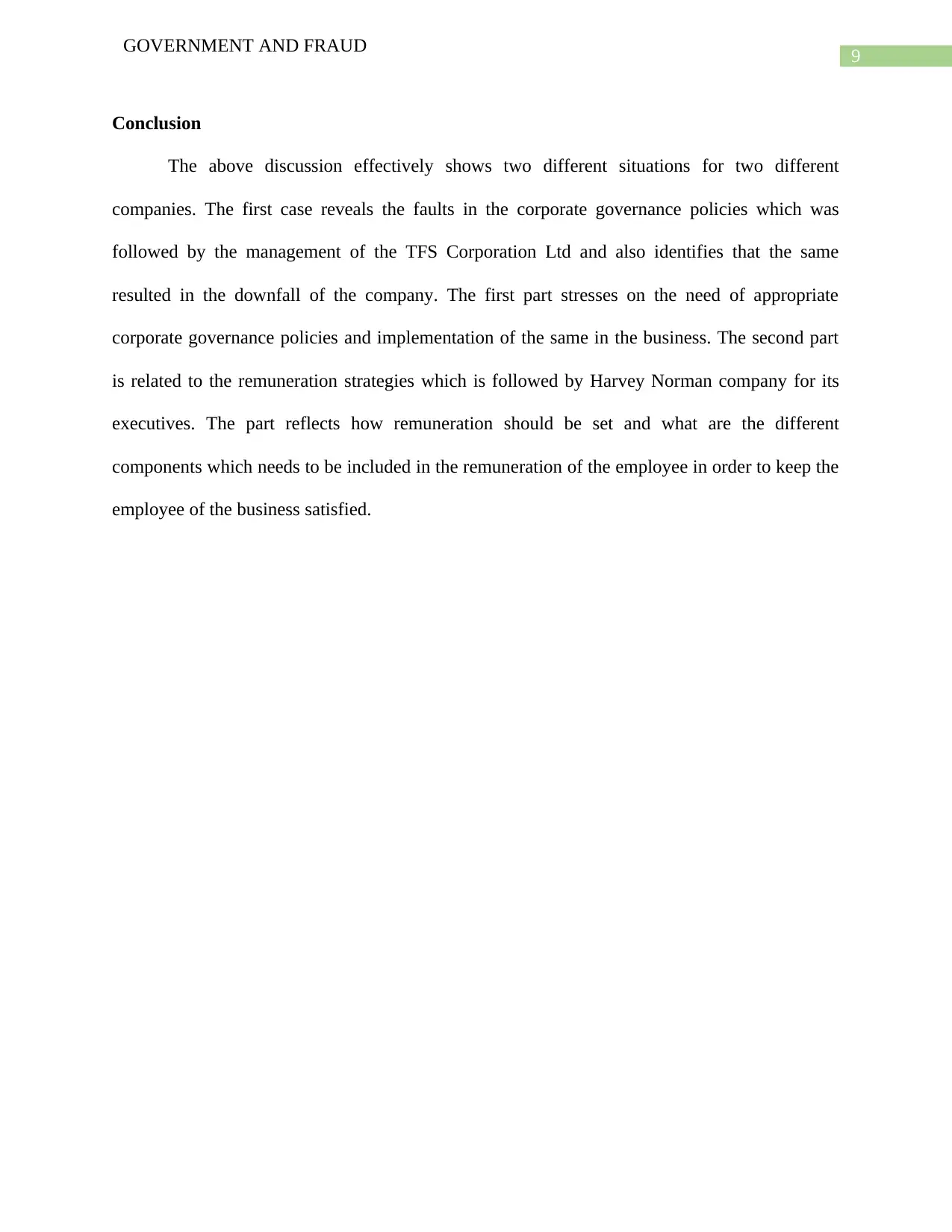
9
GOVERNMENT AND FRAUD
Conclusion
The above discussion effectively shows two different situations for two different
companies. The first case reveals the faults in the corporate governance policies which was
followed by the management of the TFS Corporation Ltd and also identifies that the same
resulted in the downfall of the company. The first part stresses on the need of appropriate
corporate governance policies and implementation of the same in the business. The second part
is related to the remuneration strategies which is followed by Harvey Norman company for its
executives. The part reflects how remuneration should be set and what are the different
components which needs to be included in the remuneration of the employee in order to keep the
employee of the business satisfied.
GOVERNMENT AND FRAUD
Conclusion
The above discussion effectively shows two different situations for two different
companies. The first case reveals the faults in the corporate governance policies which was
followed by the management of the TFS Corporation Ltd and also identifies that the same
resulted in the downfall of the company. The first part stresses on the need of appropriate
corporate governance policies and implementation of the same in the business. The second part
is related to the remuneration strategies which is followed by Harvey Norman company for its
executives. The part reflects how remuneration should be set and what are the different
components which needs to be included in the remuneration of the employee in order to keep the
employee of the business satisfied.
Paraphrase This Document
Need a fresh take? Get an instant paraphrase of this document with our AI Paraphraser
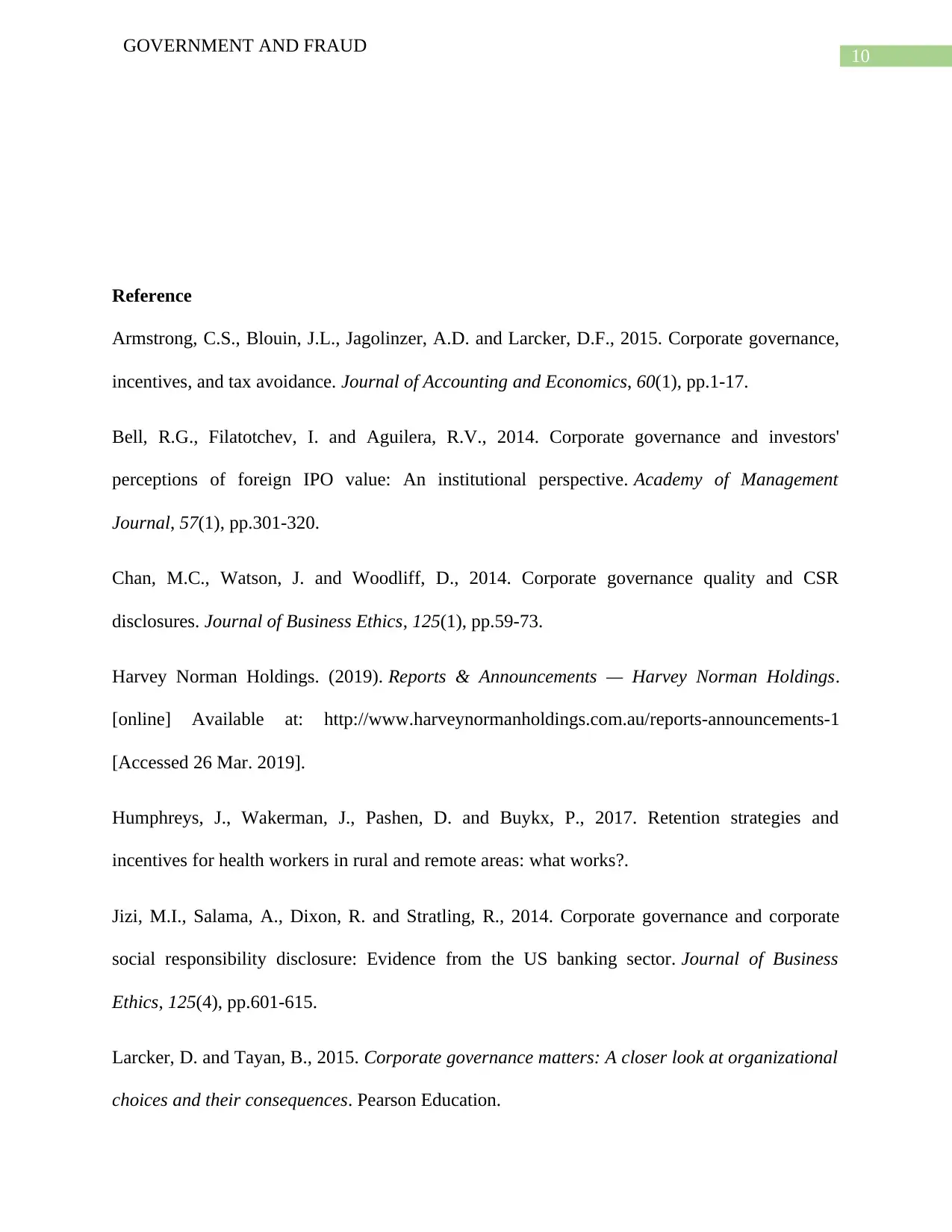
10
GOVERNMENT AND FRAUD
Reference
Armstrong, C.S., Blouin, J.L., Jagolinzer, A.D. and Larcker, D.F., 2015. Corporate governance,
incentives, and tax avoidance. Journal of Accounting and Economics, 60(1), pp.1-17.
Bell, R.G., Filatotchev, I. and Aguilera, R.V., 2014. Corporate governance and investors'
perceptions of foreign IPO value: An institutional perspective. Academy of Management
Journal, 57(1), pp.301-320.
Chan, M.C., Watson, J. and Woodliff, D., 2014. Corporate governance quality and CSR
disclosures. Journal of Business Ethics, 125(1), pp.59-73.
Harvey Norman Holdings. (2019). Reports & Announcements — Harvey Norman Holdings.
[online] Available at: http://www.harveynormanholdings.com.au/reports-announcements-1
[Accessed 26 Mar. 2019].
Humphreys, J., Wakerman, J., Pashen, D. and Buykx, P., 2017. Retention strategies and
incentives for health workers in rural and remote areas: what works?.
Jizi, M.I., Salama, A., Dixon, R. and Stratling, R., 2014. Corporate governance and corporate
social responsibility disclosure: Evidence from the US banking sector. Journal of Business
Ethics, 125(4), pp.601-615.
Larcker, D. and Tayan, B., 2015. Corporate governance matters: A closer look at organizational
choices and their consequences. Pearson Education.
GOVERNMENT AND FRAUD
Reference
Armstrong, C.S., Blouin, J.L., Jagolinzer, A.D. and Larcker, D.F., 2015. Corporate governance,
incentives, and tax avoidance. Journal of Accounting and Economics, 60(1), pp.1-17.
Bell, R.G., Filatotchev, I. and Aguilera, R.V., 2014. Corporate governance and investors'
perceptions of foreign IPO value: An institutional perspective. Academy of Management
Journal, 57(1), pp.301-320.
Chan, M.C., Watson, J. and Woodliff, D., 2014. Corporate governance quality and CSR
disclosures. Journal of Business Ethics, 125(1), pp.59-73.
Harvey Norman Holdings. (2019). Reports & Announcements — Harvey Norman Holdings.
[online] Available at: http://www.harveynormanholdings.com.au/reports-announcements-1
[Accessed 26 Mar. 2019].
Humphreys, J., Wakerman, J., Pashen, D. and Buykx, P., 2017. Retention strategies and
incentives for health workers in rural and remote areas: what works?.
Jizi, M.I., Salama, A., Dixon, R. and Stratling, R., 2014. Corporate governance and corporate
social responsibility disclosure: Evidence from the US banking sector. Journal of Business
Ethics, 125(4), pp.601-615.
Larcker, D. and Tayan, B., 2015. Corporate governance matters: A closer look at organizational
choices and their consequences. Pearson Education.
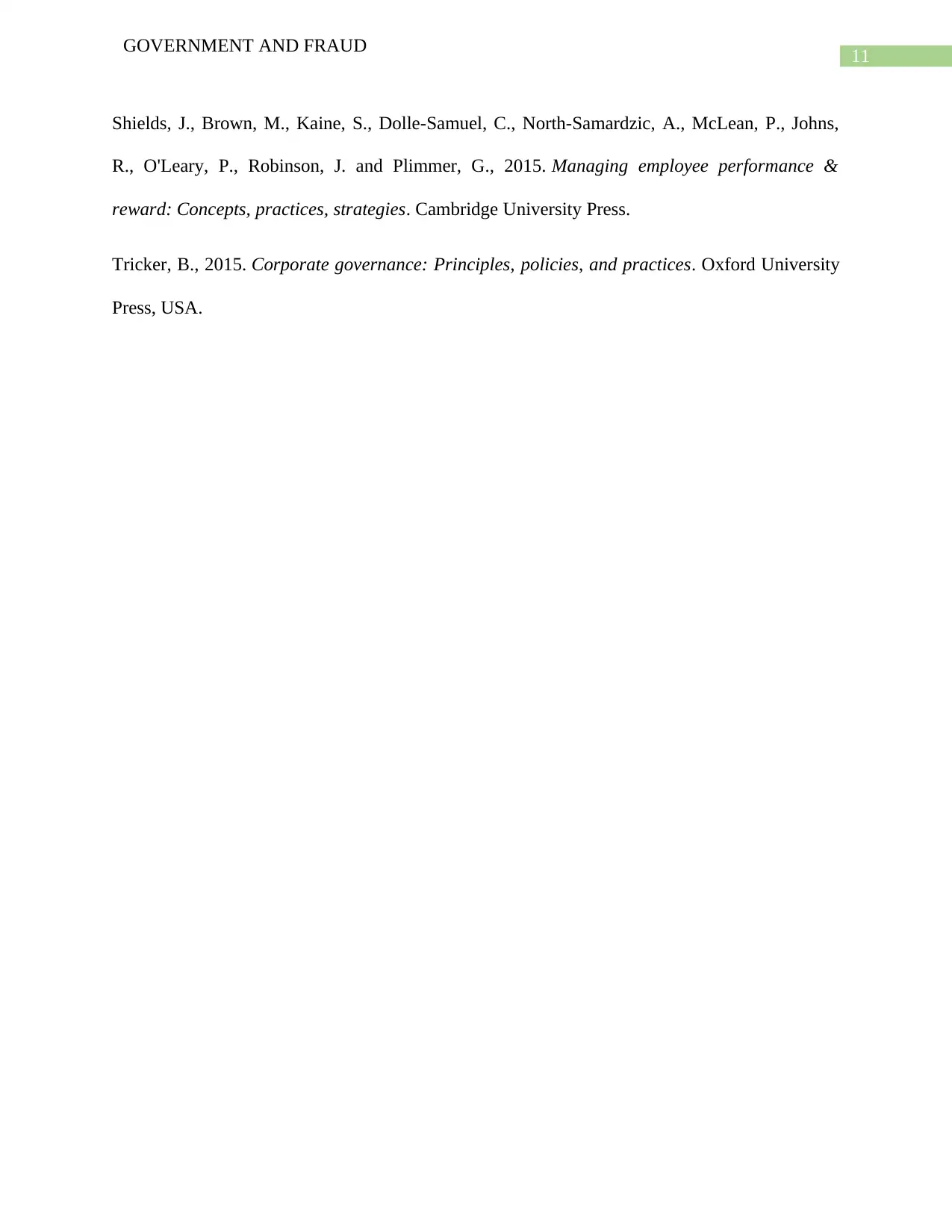
11
GOVERNMENT AND FRAUD
Shields, J., Brown, M., Kaine, S., Dolle-Samuel, C., North-Samardzic, A., McLean, P., Johns,
R., O'Leary, P., Robinson, J. and Plimmer, G., 2015. Managing employee performance &
reward: Concepts, practices, strategies. Cambridge University Press.
Tricker, B., 2015. Corporate governance: Principles, policies, and practices. Oxford University
Press, USA.
GOVERNMENT AND FRAUD
Shields, J., Brown, M., Kaine, S., Dolle-Samuel, C., North-Samardzic, A., McLean, P., Johns,
R., O'Leary, P., Robinson, J. and Plimmer, G., 2015. Managing employee performance &
reward: Concepts, practices, strategies. Cambridge University Press.
Tricker, B., 2015. Corporate governance: Principles, policies, and practices. Oxford University
Press, USA.
⊘ This is a preview!⊘
Do you want full access?
Subscribe today to unlock all pages.

Trusted by 1+ million students worldwide
1 out of 12
Related Documents
Your All-in-One AI-Powered Toolkit for Academic Success.
+13062052269
info@desklib.com
Available 24*7 on WhatsApp / Email
![[object Object]](/_next/static/media/star-bottom.7253800d.svg)
Unlock your academic potential
Copyright © 2020–2025 A2Z Services. All Rights Reserved. Developed and managed by ZUCOL.





